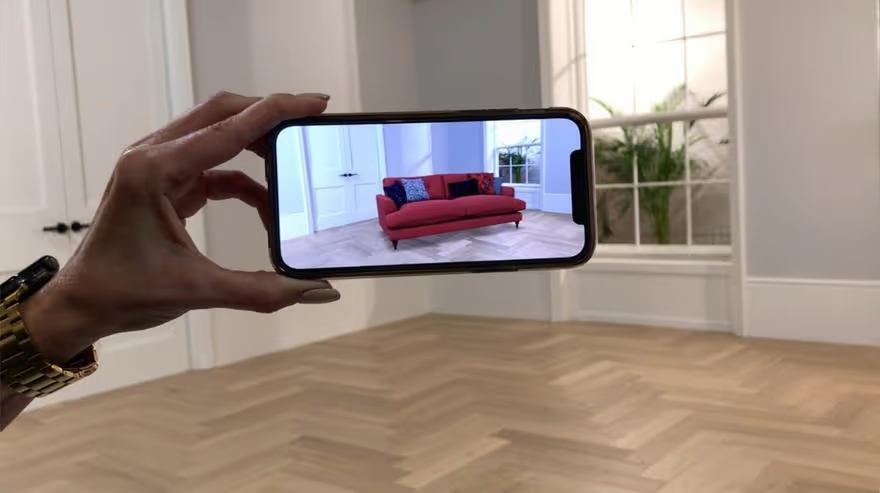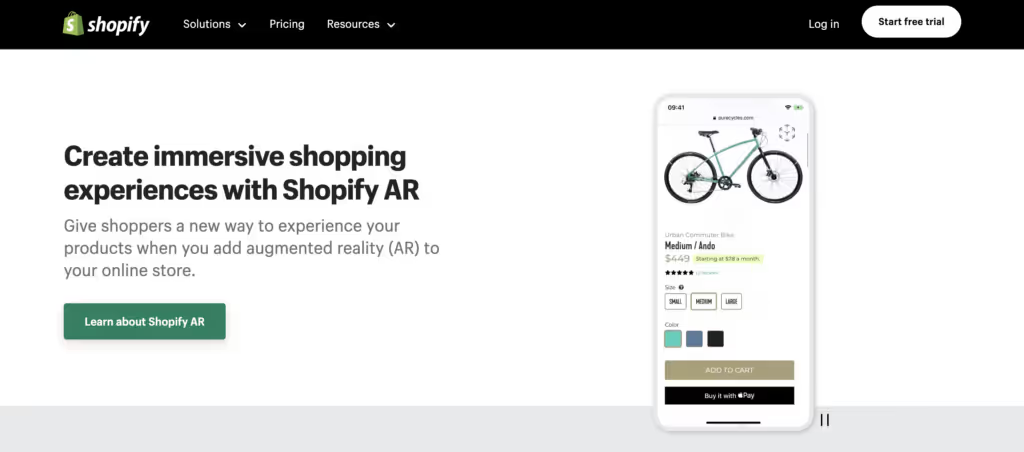A new dimension of shopping: The power of Augmented Reality (AR) in ecommerce

As we catapult into the age of technological innovation, the ecommerce landscape is undergoing a remarkable transformation. The introduction of machine learning and augmented reality (AR) into the world of online shopping has paved the way for a vibrant, immersive, and engaging customer experience that transcends the conventional norms of retail.
The excitement surrounding augmented reality in ecommerce is echoed by a survey from McKinsey, which revealed a growing interest in AR and VR technology for shopping, with almost half of the respondents expressing interest in these transformative technologies.
The power of augmented reality for business extends far beyond just a novel concept; it's a game-changing strategy rapidly gaining traction among marketers and businesses. The US AR/VR market alone is projected to exceed a staggering $248 billion by 2030.
In a digital-first world where brands are vying for consumers' attention, the integration of augmented reality in ecommerce strategies is a necessity for survival and growth. As we delve deeper into this topic, we will uncover the intricate nuances of AR, its profound impact on ecommerce, and how businesses can leverage this technology for a sustainable competitive advantage.
Understanding Augmented Reality (AR)
Augmented reality is an innovative technology that superimposes computer-generated information such as images, sounds, and text onto our real-world environment, thereby creating a composite view that augments the reality we perceive.
An example of AR that many of us might be familiar with is the first-down lines seen in televised football games or the projected flight paths in hockey and golf broadcasts. This integration of digitally-rendered information into a real-world setting enhances viewers' understanding and enjoyment of the game.
This technology has also found extensive use in video games, particularly first-person shooters, and smartphone applications. Looking to the future, it could potentially revolutionize everyday experiences by adding informational displays to lightweight sunglasses or integrating personal identification tags into social networking displays.
It's important to emphasize that augmented reality technology is not just a tool but a medium. This distinction is critical because it directs our focus towards the content being presented, rather than just the technology delivering it. An AR application, irrespective of its technological sophistication, would hold little value if it doesn’t deliver engaging and useful content to its users.
Hence, the success of an AR experience heavily depends on the quality and relevance of the content being augmented onto the user's reality.

Benefits of augmented reality for ecommerce
As online shopping continues to grow, it presents businesses with innovative ways to engage customers and enhance their shopping experiences. Here's how leveraging AR for your ecommerce store can set you up for success:
Improve customer engagement
AR significantly enhances the shopping experience by making it more interactive and engaging. With features like virtual try-on, virtual showrooms, AR mirrors, and in-store gamification, customers can actively participate in the shopping process.
Through virtual try-on features, customers can visualize how a piece of clothing or accessory would look on them without leaving their homes. This interactive process keeps the customer engaged and could lead to longer browsing times and increased chances of making a purchase.
This feature is particularly useful for businesses in the fashion and beauty industry, like Sephora, which offers a makeup try-on filter. Other brands like L'Oreal, DFS, and ASOS have also successfully implemented AR, resulting in increased sales and customer satisfaction. Virtual try-on experiences have proven to be a successful way to reduce return rates and increase conversion rates.
Moreover, AR mirrors can engage customers in a virtual shopping experience akin to in-person shopping, where they can try on products like cosmetics. AR-powered social media filters also add a layer of entertainment and personalization, encouraging customers to share their experiences, thereby promoting the brand and product organically. Brands like MAC Cosmetics and Tesco have implemented smart mirrors and AR gamification, thereby enhancing the in-store shopping experience.

Boost conversion rates
AR enhances the customer's ability to make informed purchase decisions by allowing them to visualize products in a real-life context.
For instance, a furniture store can provide an AR feature that lets customers place virtual objects in their own spaces, helping them determine whether a piece of furniture matches their room aesthetics and fits the available space. This ability to 'try before you buy' gives customers confidence in their purchasing decisions and can significantly increase conversion rates.

Similarly, interactive AR user manuals can help customers understand how to assemble or use a product, thus reducing the perceived complexity and making the product more appealing.
Reduce return rates
AR also addresses one of the main challenges in ecommerce—product returns. Since AR provides a more realistic and accurate representation of products, it can significantly help reduce return rates.
For instance, customers can use AR to visualize the size, color, texture, and fit of a product, reducing the discrepancy between expectation and reality, which is a common reason for product returns in ecommerce.
By enabling customers to visualize products in their own environment or on themselves, AR can help ensure that what customers see is what they get, leading to increased customer satisfaction and reduced return rates.
Trends in augmented reality shopping

This field is witnessing rapid innovation and adoption in various sectors, particularly in shopping and retail. Several notable trends are emerging in AR shopping that promise to redefine the way consumers interact with products and make purchasing decisions.
One of the most significant trends is the integration of AR into live-stream shopping. With this integration, users can try on products and visualize them in real time, dramatically enhancing the online shopping experience. Furthermore, AR's integration into live shopping facilitates the easy incorporation of influencer marketing, driving advancements and expanding its accessibility.
Web AR, another growing trend, is also shaping the shopping landscape. By allowing experiences directly on mobile web browsers without the need for additional apps, it makes AR content more accessible, thereby expanding its reach.
Moreover, artificial intelligence (AI) is playing an increasingly crucial role in enhancing AR shopping experiences. AR and AI are collaborating to power facial and spatial recognition, improving the accuracy and efficiency of augmented reality applications. For instance, AI can help AR systems understand the specific context of the user's environment, enabling a more precise and personalized shopping experience.
Implementing augmented reality in your ecommerce strategy
Augmented reality offers a solution to many limitations of online shopping by providing more immersive experiences. It enhances the real world by overlaying digital elements, adding an interactive dimension to online shopping. With AR, customers can visualize products in their own environments, which improves customer engagement and ultimately drives sales.
Below are a few essential tactics you may want to follow for more effective implementation of AR for growing your ecommerce business.
Choose the type of AR applications you want to implement
There are several ways this revolutionary technology can be integrated into ecommerce:
- Virtual try-on: Virtual try-on is an AR application that allows customers to virtually 'try on' products such as clothing, accessories, or makeup from the comfort of their homes. For example, a customer interested in buying sunglasses can use their device's camera to superimpose a 3D model of the sunglasses onto their face, giving them a realistic idea of how they would look wearing the sunglasses.
- Virtual showrooms: Virtual showrooms leverage AR to provide a detailed, immersive, and interactive view of a collection of products in a simulated environment. For example, a furniture retailer could create a virtual showroom where customers can explore different room setups and directly interact with the furniture items. Customers can see how different pieces of furniture look together, move them around, and even view them in their own living space.
- AR mirrors: These are digital screens that use AR technology to show customers how they would look in certain clothing items, accessories, or even with different hairstyles or makeup looks. Customers stand in front of the AR mirror, which overlays the selected products onto their reflection in real time.
This AR application is common in physical retail stores but can also be leveraged for online shopping through a device's front-facing camera. This not only creates a fun, interactive shopping experience but also allows customers to try a larger range of products in a shorter amount of time.
- In-store gamification: In-store gamification uses AR to engage customers with entertaining, game-like experiences while shopping. These games can encourage customers to interact more with the brand, explore a wider range of products, and even drive specific customer behaviors, such as visiting certain areas of the store or checking out promotional items.
Although this AR application is often associated with physical retail environments, it can also be applied to online shopping, such as through interactive product explorations or branded mini-games.
- Product placement preview: AR product placement preview allows customers to visualize products in their own space before making a purchase. For example, a customer interested in a new coffee table can see how it would look in their living room using AR. This feature helps customers to visualize the size, color, and style of the product in context, which can lead to more confident buying decisions and lower return rates.
- Interactive user manuals: Interactive user manuals leverage AR technology to provide a dynamic, engaging, and highly visual guide for product assembly or use. Rather than flipping through a traditional paper manual, customers can use their device's camera to superimpose step-by-step instructions onto the real-world product. For instance, a customer who has purchased a DIY furniture piece can aim their phone at the disassembled parts, and the AR application would project a 3D model demonstrating the assembly process in real-time. Each step is visualized directly on the actual product parts, making the instructions easier to follow.
Select suitable AR tools
Choosing the right tools largely depends on your business objectives and product offerings.
These options offer different ways to engage customers and showcase products:
- Marker-based AR recognizes objects and displays 3D models, while markerless AR allows users to place virtual objects anywhere.
- Location-based AR uses geographic location to present digital content, and projection-based ARprojects synthetic light onto physical surfaces.
Integrate augmented reality into your ecommerce platform
Many ecommerce platforms provide features for integrating this technology into your online store. For instance, Shopify offers guidance in AR integration and hosts related product media. Utilizing these features can help to streamline the process of adding AR capabilities to your ecommerce site.

Market the AR experience
After integrating AR, it's important to market this experience to your customers. Companies like Christian Dior have successfully used social media apps and camera filters to engage customers and create virtual word-of-mouth marketing. Additionally, using AR in advertising can enhance customer engagement and has been projected to generate substantial revenue.

Evaluate the success of your implementation
Finally, it's important to continually evaluate the success of your AR implementation and make adjustments as needed. This can involve tracking metrics such as customer engagement, sales, and customer feedback. These insights can help you understand how effectively the features are meeting your business objectives and inform any necessary changes.
Summary
We are undoubtedly standing on the brink of a new era in ecommerce, where augmented reality is gradually weaving itself into the fabric of the online shopping experience. From the transformation of pre-buying experiences to the enhancement of consumer engagement, augmented reality in ecommerce has cemented its position as a potent tool for business growth.
However, while the adoption of AR is a promising development, it is essential to remember that the successful implementation of augmented reality in ecommerce is contingent on user comfort with technology and its seamless integration into the purchasing process. As we move forward, businesses should continually adapt and refine their AR strategies to meet evolving consumer needs and technological advancements.
The story of augmented reality in ecommerce is just the beginning. With generational turnover and the comfort of younger generations with augmented and virtual reality technology, we can look forward to an exciting future where the virtual and physical realms of shopping continue to intertwine in novel and extraordinary ways.




